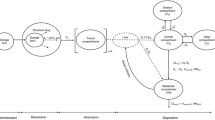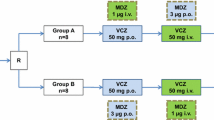Abstract
Plasma concentrations of total and unbound sulfisoxazole were followed after single intravenous and oral doses of 1 g sulfisoxazole and during a 500-mg, four-time-a-day dosing regimen in six healthy males, using a specific high pressure liquid Chromatographic assay method. Saturable plasma protein binding was observed at total concentrations above 80–100 mg/liter. The clearance of sulfisoxazole was 18.7±3.9ml/min for total drug and 232±64ml/min for unbound drug. Renal elimination, on the average, accounted for 49% of the clearance of sulfisoxazole. The apparent volume of distribution for total drug was 10.9±2.0 liters and 136±36 liters for unbound drug, indicating that sulfisoxazole is primarily distributed extracellularly. Accumulation of N4-acetyl-sulfisoxazole during multiple dosing did not affect the disposition of sulfisoxazole. Adjusting for variable renal clearances between oral and intravenous administration and using the unbound plasma concentrations, the bioavailability for an oral dose of sulfisoxazole was found to be 0.95±0.04.
Similar content being viewed by others
References
Anonymous. The choice of antimicrobial drugs.Med. Lett. Drugs Ther. 18:9–16 (1976).
B. M. Kagan.Antimicrobial Therapy, 2nd ed., W. B. Saunders, Philadelphia, 1975.
Anonymous. The top 200 drugs.Pharm. Times 46:31–39 (1980).
A. C. Bratton and E. K. Marshall, Jr. A new coupling component for sulfanilamide determination.J. Biol. Chem. 128:537–550 (1939).
J. Rieder. Quantitative determination of the bacteriostatically active fraction of sulfonamides and the sum of their inactive metabolites in the body fluids.Chemotherapy 17:1–21 (1972).
S. A. Kaplan, R. E. Weinfeld, C. W. Abruzzo, and M. Lewis. Pharmacokinetic profile of sulfisoxazole following intravenous, intramuscular and oral administration to man.J. Pharm. Sci. 61:773–778 (1972).
E. Nelson and I. O'Reiily. Kinetics of sulfisoxazole acetylation and excretion in humans.J. Pharmacol. Exp. Ther. 129:368–372 (1960).
M. M. Reidenberg, H. Kostenbauder, and W. P. Adams. Rate of drug metabolism in obese volunteers before and during starvation and in azotemic patients.Metabolism 18:209–213 (1969).
S. H. Curry. InDrug Disposition and Phamacokinetics, 2nd ed., Blackwell Science Publishers, Oxford, 1966, p. 191.
L. Dettli and P. Spring. In E. J. Ariëns (ed.),Physico-Chemical Aspects of Drug Action, Vol. 7, Pergamon, Oxford, 1966, pp. 5–37.
T. Kawamura, N. Yagi, Y. Kazutama, M. Ohnishi, J.-I. Kadowaki, and M. Takada. Protein binding of sulfonamides and displacing effects of sulfinpyrazone on the bound sulfonamides in nephrotic patients in the remissive stage.Chem. Pharm. Bull. Tokyo 28:1331–1356 (1980).
G. Levy, T. Baliah, and J. A. Procknal. Effect of renal transplantation on protein binding of drugs in serum of donor and recipient.Clin. Pharmacol. Ther. 20:512–516 (1976).
R. Zini, P. d'Athis, A. Hoareau, and J. P. Tillement. Binding of four sulphonamides to human albumin.Eur. J. Clin. Pharmacol. 10:139–145 (1976).
J. Rieder. Physikalisch-chemische und biologische Untersuchungen an Sulfonamiden.Arzneim. Forsch. 13:81–88 (1963).
A. H. Anton. Increasing activity of sulfonamides with displacing agents: a review.Ann. N.Y. Acad. Sci. 226:23–292 (1973).
D. Jung and S. Øie. “High pressure” liquid chromatography of sulfisoxazole and N4-acetylsulfisoxazole in body fluids.Clin. Chem. 26:51–54 (1980).
N. Holford. MULTIFUN. In H. M. Perry and J. J. Wood (eds.),Public Procedures Notebook. Bolt Beranek and Newman, Inc., Cambridge, Mass., 1979.
N. Holford. DRUGFUN. In H. M. Perry and J. J. Wood (eds.),Public Procedures Notebook. Bolt Beranek and Newman, Inc., Cambridge, Mass., 1979.
P. A. Castleman, D. H. Russell, F. N. Webb, C. A. Hollister, J. R. Siege, S. R. Zdonik, and D. M. Fram. The implementation of the PROPHET system.Natl. Computer Conf. Exp. Proc. 43:457–468 (1974).
L. Z. Benet and R. L. Galeazzi. Noncompartmental determination of the steady-state volume of distribution.J. Pharm. Sci. 68:1071–1074 (1979).
M. Gibaldi and D. Perrier. InPharmacokinetics. Marcel Dekker, New York, 1975, p. 224.
J. G. Wagner. InBiopharmaceuticals and Relevant Pharmacokinetics. Drug Intelligence Publications, Hamilton, Ill., 1971, p. 182.
S. Øie and D. Jung. Bioavailability under variable renal clearance.J. Pharm. Sci. 68:128–129 (1979).
S. Øie, T. W. Guentert, and T. N. Tozer. Effect of saturable binding on the pharmacokinetics of drugs: a simulation.J. Pharm. Pharmacol. 32:471–477 (1980).
S. Øie and T. N. Tozer. Effect of altered plasma protein binding on apparent volume of distribution.J. Pharm. Sci. 68:1203–1205 (1979).
G. M. Rubin, T. N. Tozer, and S. Øie. Concentration-dependence of salicylate distribution.Pharm. Sci., submitted for publication.
S. Øie. Effect of 4-N-acetyl-sulfisoxazole on the disposition of sulfisoxazole in the rat.Int. J. Pharmaceut.3:311–319 (1979).
D. Jung and S. Øie. Decreasedin vivo acetylation of sulfisoxazole in the rabbit in the presence of 4-N-acetyl-sulfisoxazole.Int. J. Pharmaceut. 7:179–188 (1981).
G. R. Wilkinson and D. G. Shand. A physiological approach to hepatic drug clearance.Clin. Pharmacol. Ther. 18:377–390 (1975).
T. Uno and M. Kono. Studies on the metabolism of sulfisoxazole. 1. On the excrements in the human urine after administration of sulfisoxazole.Jpn. J. Pharm. Sci. 80:201–204 (1960).
Author information
Authors and Affiliations
Additional information
Supported in part by grant GM 25807 from the National Institutes of Health.
Rights and permissions
About this article
Cite this article
Øie, S., Gambertoglio, J.G. & Fleckenstein, L. Comparison of the disposition of total and unbound sulfisoxazole after single and multiple dosing. Journal of Pharmacokinetics and Biopharmaceutics 10, 157–172 (1982). https://doi.org/10.1007/BF01062333
Received:
Revised:
Published:
Issue Date:
DOI: https://doi.org/10.1007/BF01062333




